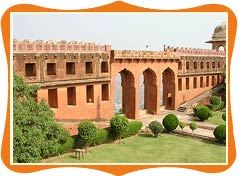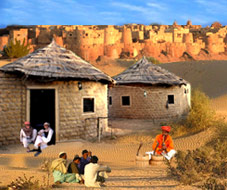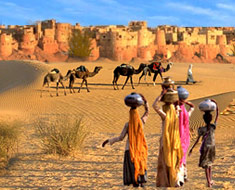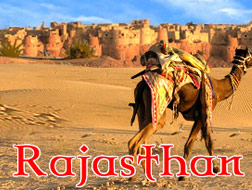 Jaigarh fort, also known as the fort of victory, is one of the three hilltop forts that overlook the pink city of Jaipur. Situated approximately 15 km away from Jaipur on the hill premonitory called Cheel ka Teela (Hill of eagles) of the Aravali hill ranges, the fort was constructed between 15th and 18th centuries. As comprehended by its citadel kind of architectural style, the fort is one among the few military structures of medieval India, the heritage of which - palaces, gardens, a granary, an armory, several temples, and a tall tower, is almost intact. The entrance of the fort is from Dungar Darwaza, leading towards a steep road entry into the fort. The view of Jaipur city from this fort is one which would keep the spectators captivated for hours. One can find a well-planned cannon foundry, several temples, a granary, and a tall tower within the fort complex. Jaigarh Fort is also famous for housing the world's largest canon on wheels, Jai Ban (Jaivan).
Jaigarh fort, also known as the fort of victory, is one of the three hilltop forts that overlook the pink city of Jaipur. Situated approximately 15 km away from Jaipur on the hill premonitory called Cheel ka Teela (Hill of eagles) of the Aravali hill ranges, the fort was constructed between 15th and 18th centuries. As comprehended by its citadel kind of architectural style, the fort is one among the few military structures of medieval India, the heritage of which - palaces, gardens, a granary, an armory, several temples, and a tall tower, is almost intact. The entrance of the fort is from Dungar Darwaza, leading towards a steep road entry into the fort. The view of Jaipur city from this fort is one which would keep the spectators captivated for hours. One can find a well-planned cannon foundry, several temples, a granary, and a tall tower within the fort complex. Jaigarh Fort is also famous for housing the world's largest canon on wheels, Jai Ban (Jaivan).The fact that Jaigarh Fort has environment-friendly three water conservation reservoirs that are a part of rain-water harvesting system made it an ideal place in times of war since large amounts of water could be stored here. The fort is, undoubtedly, the most commanding fort of Jaipur city and hence, was christened as the victory fort. At the meeting Hall of Warriors or Shubhat Niwas, one can find huge drums used for important announcements. While the Jaigarh Fort is perched on top of a hill, the Amber Fort is on the foothills. It is believed that both the forts are connected through a well-guarded passage. Besides, there is also a watch tower located in the centre of the fort, built on a raised ground that provides excellent view of the distant landscapes. Other than this, there are two temples, namely, Ram Harihar Temple of the 10th century and the Kal Bhairav Temple of the 12th century, located inside the premises of the fort.
A rich collection of arms and ammunitions made the fort a principal place of manufacturing armory. The collection, here, includes swords, muskets, canons, shields, guns, and a 50 kg cannon ball. You can also find a huge collection of ancient coins and puppets within the fort complex. The fort was also used as a treasury by the royal house of Jaipur. Apart from this, there is a museum near the Awami gate that displays photographs of the royalty of Jaipur, stamps, and many artifacts including a circular pack of cards. A spittoon of the 15th century and a hand drawn blueprint of palaces are also exhibited inside the museum. Sometime back, rumors had it that a royal treasure is buried somewhere in the fort, due to which the fort was shut down for seven years but nothing was discovered during the excavation operations. Since then, the fort is open for public viewing continuously.
Jaigarh Fort is open for public from 9.00 AM to 4.30 PM.










